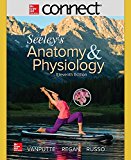
Concept explainers
Case Summary
The autonomic nervous system (ANS) causes dilation of the pupil of eye after seeing a pleasurable object.
Adequate Information:
The autonomic nervous system is a part of the peripheral nervous system, which controls and coordinates the activities of the organs. The nerve cells of the ANS are attached to the smooth muscles of the organ.
To determine:
The part of the ANS causes dilation of the pupil and the nerve pathway involved in this.
Given Information:
ANS has two important divisions’ sympathetic and parasympathetic systems, which help in regulating the activity of specific structures. They are present on the preganglionic neuron of the CNS and autonomic ganglia of the PNS. The sympathetic axons travel through the sympathetic chain ganglia to their target cell.
Want to see the full answer?
Check out a sample textbook solution
Chapter 16 Solutions
Connect with LearnSmart Labs Access Card for Seeley's A&P
- Which of the following is the best way to describe how the ANS is controlled? (a) completely under control of voluntary cerebral cortex, (b) entirely controls itself, (c) completely under control of brain stem, (d) little control by cerebrum, major control by hypothalamus and amygdaloid body, and major control by spinal and peripheral reflexes.arrow_forwardClassify the following as ascending or descending tracts and what type of impulses are conducted by them. Reticulospinal, Corticospinal, spinothalamic, spinocerebellar, and rubrospinal tract.arrow_forwardAs the aroma of freshly brewed coffee drifted by Joe’s nose, his mouth began to water, and his stomach started to rumble. Explain these reactions in terms of ANS activity.arrow_forward
- Maintaining a resting level of ANS activity in a cell is called a. autonomic tone. b. cooperative effect. c. dual innervation. d. antagonistic effect.arrow_forwardExplain dual innervation of the ANS.arrow_forwardAn individual has a spinal cord injury superior to the area involved in the patellar reflex circuit such that all communication to the brain is broken off. How would this affect the operation of the patellar reflex circuit?arrow_forward
- Explain the physiology of ascending pathways by placing each word or phrase into the blanks to complete the sentences. posterior horn tactile corpuscles spinoreticular tract primary somatosensory anterior horn spinothalamic tract contralateral ipsilateral prior to decussation A feather is rubbed over a section of skin on the palm of the hand, eliciting an action potential that was generated from neurons associated with Action potentials traveling in the posterior root reach the synapse with second order neurons located in the of the spinal cord. The transfer of electrical signals between first and second order neurons occurs Second order neurons ascend the spinal cord in the Arriving on the transferred to third order neurons. side of the thalamus, action potentials are Third order neurons arrive in the comprehension occurs. Reset cortex, where consciousarrow_forwardWhich part of the brain is the main integration center of the ANS? Which part exerts the most direct influence over autonomic functions?arrow_forwarddescribe three things about the autonomic nervous system (ANS)and In those three things, be sure to contrast the differences between the sympathetic and parasympathetic systems. Also, include what might happen if a portion of the ANS malfunctioned. "NOT A HOMEWORK ASSIGNMENT"arrow_forward
- Describe the function of the ANS.arrow_forwardIdentify the location of the cell bodies of second order neurons of the Dorsal column medial lemniscus pathway? Ventral horn Dorsal root ganglia Dorsal horn Thalamus Medullaarrow_forwardA patient is admitted to the hospital after having a cerebral vascular accident (CVA) otherwise known as a stroke. Upon assessment of muscle strength it is determined that she has left-sided weakness. What specific part of the cerebrum was injured?arrow_forward
 Human Physiology: From Cells to Systems (MindTap ...BiologyISBN:9781285866932Author:Lauralee SherwoodPublisher:Cengage Learning
Human Physiology: From Cells to Systems (MindTap ...BiologyISBN:9781285866932Author:Lauralee SherwoodPublisher:Cengage Learning


